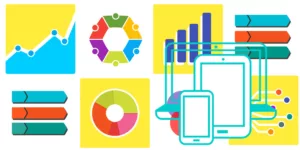There are over 4.5 million iOS and Android apps on the marketplace these days. At Tecsynt we develop them every day . For any need and for the most demanding user. Which It means as an app developer you’ll have to fight two battles at the same time – to compete with other apps on the App Store or Google Play store and to fight for an app user’s attention and the time he or she spends on your app. Hard, I know, but with a good marketing campaign and a well-thought-out business plan everything is possible.
Now, let’s talk about success and victory, shall we? You built your app already, promoted and launched it, right? Okay, what should you do next? Time to start obtaining some data about its success and profit. What is the number of your app downloads? Is your target audience participate enough to make the revenue grow? How exactly your application is being used? How users behave when they interact with your mobile app? How much money are you making? To get answers to these questions and many others you should seek the help of mobile app analytics tools. What is this and where to start?
Mobile app analytics tools allow you:
- to explore user’s behavior in your app;
- to track incoming channels to find out how user discovered your app;
- to track your app’s performance and how frequently users complete conversion goals;
- to get an accurate picture of what users encounter with and fix them.
Analytics tools are for developers who are looking to improve their apps functionality, track crashes and to keep their mobile apps up-to-date and bugs free. Nowadays mobile app developers can choose from a huge range of the best mobile analytics platforms with many powerful free options. And here is the question you want to ask, I’m sure. How to choose the right tool to achieve your goals?
Well, it’s all about metrics of the mobile app. According to Dave McClure, the key metrics for startups and their app analytics interpretation are:
- Acquisition – allows you to discover the channels your users came from;
- Activation – shows the percentage of customers with happy experience;
- Retention – lets you know how many of your clients opened your app after downloading it;
- Referral – helps you to see whether they liked the product enough to share with their friends;
- Revenue – gives you an understanding of whether such user behavior may be monetized.
It’s easy to focus on your app’s downloads, revenue and reviews number, but by using the mobile app analytic tools you can also get a valuable insight people’s behavior and how exactly they use your app. Finding the right mobile app analytics solution can be challenging. There are a few important things you need to keep in mind. Ease of integration is crucial, so try to find a path of least resistance. And real-time data and security are also important factors to remember while choosing the necessary analytic tool.
If you want to take your app to the next level, make a suitable optimizations and keep users interested in your product, therefore, make more money, here is the list of the best mobile app analytics tools that will help you understand how people are using your app, where the pitfalls are and how to take your app to the top rank of the app store.
So, what are the best tools for a mobile app analytics?
1. GOOGLE ANALYTICS FOR MOBILE APPS
This tool is like… literally in every top 10 of the best analytics tools for mobile apps around the world. A favorite of developers and webmasters. Analytics for Mobile Apps is part of Universal Google Analytics — a cross-device analytics system that allows you to measure user’s behavior using Google’s User ID system.
It’s totally has everything you need to get started with analytics. If you already had an experience with Google Analytics for web, you’ll have no problem to get used to the mobile app version. Keep in mind, if your business relies on a native mobile app, you’ll need to tell Google Analytics which platforms it supports – iOS or Android.
Behaviour reports provided by Google Analytics give you details about what users do once they’re inside your mobile app – number of screen views, average time on screen, number of screens per session and number of crashes. Conversion option is perfect for business companies who use a mobile app for commerce purposes and allows you get notifications every time you sell a product. You can set-up goals and see the flow of each goal. Google Analytics provides useful visualizations and E-commerce data on the performance of individual products.
Google Analytics organizes reports in various categories:
- Acquisitions – information about new users and how they are accessing the app for the first time;
- Mobile app audience – newly obtained and returning app users, their country, language etc.;
- Behaviour, Engagement – event tracking with reports on speed, crashes etc.;
- Mobile app behavior – allows setting up your goal and watching its flow,
- Mobile app conversion – if your app is monetized and you need to monitor your app’s conversion data.
Characteristics:
- Measurement Protocol
- Lifetime value and retention analysis
- Customization of data collection and report creation
- Constant development and enhancement
- Cross platform connection with other Google products (AdMob for monetarization of your apps; Google Play for tracking conversions)
- Customization of data collection and report creation
- Doesn’t have iTunes integration
- Cost – Free
- Platforms – iOS, Android
2. FLURRY
A free tool provided by Yahoo Mobile Developer Suite it’s one of the oldest and most respected app analytics platforms on the market thus far. This platform is concentrated mostly on acquisition metric and built for the major platforms – iOS, Android, Windows and Blackberry. As well as a number of paid optionable tools for deep analytics, a free toolkit Flurry is a great tool itself. Flurry provides data on a number of sessions, sessions’ length, active users, frequency of use, audience persona and demographic, retention. Just like Google Analytics it lets you create a conversion funnel if necessary and provides the information about devices, errors and mobile carriers. And unlike Google Analytics, Flurry does not provide any real-time usage data. As a pleasurable bonus, the UI design is intuitive, easy-to-use and is preferred by giants like Facebook and Google.
Characteristics:
- Complete mobile analytics tool
- Creation of conversion funnels
- User paths
- Uncomplicated reports on conversion metrics
- Ability to get metrics on your ad performance because of the availability of an ad network
- Lightweight SDK is easy to install and you can start getting data right away
- No cohort analysis
- No real-time analytics data
- Requires a lot of clicks to get the information
- Cost – Free
- Platforms – iOS, Android, Windows Phone, Blackberry, HTML5, Java ME.
3. APPLE APP ANALYTICS
A free analytics tool available for iOS developers who want to know how people use their apps. As a part of iTunes Connect, App Analytics sorts app data in three ways: App Store Data, Sales Data and Usage Data.
Apple’s app developer analytics allows you to track everything from app store optimization to user engagement, web traffic and crash reporting. App Store Data set lets you see how many times your app has been viewed in the App Store etc. And Usage Data allows you to find out how customers use your app, based on basic metrics like installations, sessions, and total in-app purchases.
Yes, App Analytics is relatively new, launched in 2015, and it lacks the power of Universal Analytics, but still provides a suitable amount of user data and a helpful insight into how people find and use your iOS app. It’s also probably the strongest tool for app store optimization. But if you need more deep healthcare checking and if your app isn’t iOS native you’ll have to pair it with other tools.
Characteristics:
- Filters – you can filter metrics by chosen parameter.
- Sources – basic tools for measuring the results from paid and organic traffic sources.
- Retention – lets you understand how long people are sticking around in your app.
- Heat Map Analytics – first touch, second touch, third touch, etc., screen by screen, most unresponsive gestures, most viewed screens, highest quit rates, most interactive screens
- Gesture Recognition – pinch, zoom in, zoom out, swipe to all directions, scroll, tap, double tap, triple tap, time between touches, quits, views, etc.
- Device Interactions – shake, tilt, orientation change, etc.
- User Analytics – sessions, retentions, user engagements, locations, firmware, navigation flow and devices to improve your CX.
- In-App Analytics – event-based analytics with parameters defined by you.
- Crash & Exception Analytics – indicates the number of crashes, times, reasons, class, stack trace and reproduction steps.
- Push Notification Analytics – ability to create funnels to identify your users’ reactions after push notifications.
- Advanced Conversion Funnels – ability to create both event-based and navigation based funnels to understand your users’ behaviors.
- Platforms – iOS, iTunes Connect and Windows, Android is coming soon.
- All the data is real time and the SDK is easy to integrate.
- Cost – to use it for free you have to be an Apple developer program member.
4. COUNTLY
As an open-source mobile analytics platform, it offers a free cloud service which allows for up to 10,000 sessions and events to be tracked for free across unlimited apps and users. Free services include analytics such as retention and cohorts, real-time user tracking and revenue analytics, funnels, segmentation, but crash reports come with as a paid option. Alongside this, you’ll get to see in-app purchase data. A real-time dashboard is easy to read and provides the access to the data you need immediately. They also have SDKs for more platforms than any other analytics solution.
Characteristics:
- Users and Users Loyalty information;
- Sessions and Session Frequency information;
- Locations information;
- Devices and App Versions information;
- Easy-to-use and highly responsive UI;
- Real-time analytics;
- Open Source – you can host it on your own server;
- User-permission management;
- Email and forum support;
- Platforms – iOS, Android, BlackBerry, Windows Phone, Apple Watch, Mac OS X, Unity3D, Flash;
- Cost – Community edition is free and paid options starting from $60 per month. 20% discount for startups, teachers and students. Enterprise edition – pricing based on data volume needed.
5. LEANPLUM
Leanplum is a fully integrated mobile marketing platform with various options and very handy features. The tool captures all events and behaviors associated with a user, without limits or data point costs. Their out-of-the-box insights examine engagement, retention, revenue, uninstalls, and more.
“Leanplum offers the complete mobile marketing platform, designed for intelligent action. It offers the total package: Messaging, Automation, App Editing, Personalization, A/B Testing, and Analytics. Built on a foundation of A/B Testing and Analytics, Leanplum delivers a deep customer understanding. Above and beyond that, we give you the capabilities to act on this intelligence within a single, complete platform.”
Momchil Kyurkchiev, Co-founder & CEO of Leanplum
Characteristics:
- The Analytics Dashboard – UI presenting all of your app’s key metrics and data. It can be configured to display many different views, depending on your metrics of interest. It designed for ease of use and navigation.
- The range of sophisticated filtering, grouping and cohorting tools to analyze and visualize your data.
Categorized primary dimensions of data: User Activity, Userbase, and Developer’s Activity. Any A/B Tests or Messages data will also be accessible from this left panel. - The panel that displays all of the metrics, charts and analysis tools associated with each data repository.
- Confidence Intervals – toggles the confidence interval selection. By default, confidence intervals are hidden until an A/B test is selected.
- Date Range Selector – selects the date range for which you see data (the current day, Yesterday, Last Week, Last Month, Last 3 Months, Last 6 Months, and Custom).
- Metric Selector – selects the displayed metric in the Metric Chart Graph. You can select from the general metrics listed or type in the name of an event to display a new metric.
- Actual Values – presents data as the actual counts per day.
- Cumulative Values – presents data as a running cumulative.
- Metric Tile – displays the cumulative value of a metric.
- Leanplum supports in-app purchase validation.
- Platforms – iOS, Android, Unity SDK.
- Cost – 30-day free trial.
And… if these tools don’t satisfy your needs you can also check these top app analytics tools to find the most acceptable for your goal. These app analytics tools will give you access to the detailed data you plan to analyze:
- AppAnnie
- AppSee
- AppFigures
- AppClix
- Facebook Analytics for Apps
- Mixpanel
- Apsalar
- Amplitude
- Localytics
- Fabric
- DevMate
- Piwik
- Firebase
- Medialets
- Bango
- AskingPoint
CONCLUSION
We hope, at least one of these mobile app analytics platforms will help you to achieve the goal and save some budget. Don’t rush and examine each one of the tools described above to find out which one works best for you.
Right now it’s absolutely necessary for any app developer to track the right key metrics for his app to be able to improve the product after analyzing user’s experience. Consider your mobile app marketing metrics and choose a solution that suits your purpose and will help you to run your business without heavy expenses. We encourage you to use app analytics services from this list to get more efficient results.








